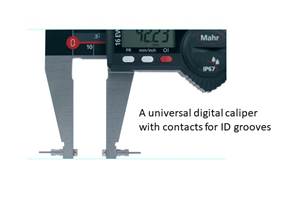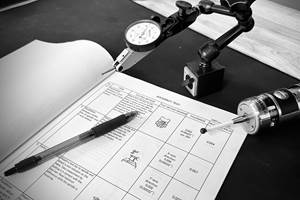A Balancing Act for Differential Gaging
Differential gaging measures using two devices, which has advantages over standard, comparative measurements using a single sensing head. These include the ability to measure size without regard to position.
Share





The differential gaging process uses two sensing devices and combines the results into one measurement. The measured dimension is the change in the position of the two sensing components.
Differential gaging has advantages over standard, comparative measurements using a single sensing head against a fixed reference surface. These include the measurement of size without regard to position (see Figure 1). When the two gage heads are in line and in an opposed position, the sensed dimension will be the change in the separation of the two gage tips; in this case, the size of the part. When measuring in this manner, the staging of the part does not become part of the measurement loop. The platen in a differential system just places the part between transducers.
There are a number of measuring systems available that can provide differential gaging, including air and electronic gaging. Air gaging is probably the most common since every two-jet air plug and air ring utilizes the differential gaging principle. Most air gages measure back-pressure that builds up in the system when the tooling is placed in close proximity to a workpiece; this results in higher air pressure, which the gage comparator converts into a dimensional value. Thus, as the plug fits into the part, it is the combination of both jets that represents the diameter of the part without regard to where in the part the plug happens to be.
The same is true with electronic probes. In this case, though, the probes are combined electronically to provide the differential measurement. Differential gaging using both air and electronic probes is used in a wide variety of applications that include measurement of form on angles, tapers and shafts without regard to the part dimensions. Also, the concentricity of two shaft diameters, comparison of a workpiece to a master, match gaging and, finally, checking the parallelism of a workpiece and its support surface are all applications of this technique.
If there is an issue with differential gaging, it is the fact that there are basically two sensing devices, whether it be two air jets combined in a single circuit or two electronic probes combined electronically in some type of amplifier system. This issue is that there are two sensors; thus, in theory, there is a potential for twice the error when the sensors are combined. For air gaging, this error is often referred to as a balance error. With electronic probes, especially when used for extremely high tolerance applications, the error is referred to as a tracking error. However, in either case, one would expect to observe that movement in one sensor is the same movement in the other.
With air gaging, using two air jets combined differentially in an air plug, checking this balance error is something that should be done as part of an annual tooling review. If an air plug is used as handheld tooling, wear will often be equal on all parts of the diameter. However, if the air plug is mounted on a holder with the jets vertical, there could be more wear on one jet sensor than the other.
The test performed is pretty simple. Ensure the air plug is mounted in its holder with the jets at the 0-degree and the 180-degree position. Then, place the master on the tooling and zero out the display. The test is performed by gently but firmly lifting the master ring, causing the ring to rest against the bottom of the body of the air tooling. Normally, two-jet air plugs automatically balance themselves when one of the jets is closer to the workpiece than the other — as is the case here, where the master is allowed to rest on the upper jet. But if one jet or orifice is damaged or worn, this test will demonstrate the gage’s inability to maintain that balance. Manufacturers of air tooling have tolerances on the balance error, and the air plug can be compared to the acceptable limits.
A combination of electronic probes used in differential gaging often has more measuring range and is sometimes used in higher-resolution applications. This combination error can be referred to as a balance error but is more often referred to as a tracking error since it is easier to plot the measuring curves of each probe and the combination. To check for this error, the process is a little more complicated, but with the correct tools, it is pretty easy.
The test here involves placing both sensors on the calibrated reference, moving it through various points along the probe’s travel and observing the difference. The moving reference surface could be a very precise micro calibrator or a set of gage blocks that represent points within the measuring range of the probes. Start by placing the probes on the reference at a point close to their electronic zero, electronically zero out the probes and display each probe and the combination on the amplifier. Then, move the probes through their range, recording the values at the designated steps. When completed, you will be able to determine the error of each probe and potentially any variance that would affect your differential measurement.
Related Content
Choosing the Correct Gage Type for Groove Inspection
Grooves play a critical functional role for seal rings and retainer rings, so good gaging practices are a must.
Read MoreProcess Control — Leveraging Machine Shop Connectivity in Real Time
Renishaw Central, the company’s new end-to-end process control software, offers a new methodology for producing families of parts through actionable data.
Read MoreHow to Choose the Correct Fixed-Body Plug Gaging Solution
The two types of fixed-body plug gages are both accurate, fast and easy to use. Consider these factors when selecting one for your gaging application.
Read More4 Ways to Establish Machine Accuracy
Understanding all the things that contribute to a machine’s full potential accuracy will inform what to prioritize when fine-tuning the machine.
Read MoreRead Next
5 Rules of Thumb for Buying CNC Machine Tools
Use these tips to carefully plan your machine tool purchases and to avoid regretting your decision later.
Read MoreBuilding Out a Foundation for Student Machinists
Autodesk and Haas have teamed up to produce an introductory course for students that covers the basics of CAD, CAM and CNC while providing them with a portfolio part.
Read MoreRegistration Now Open for the Precision Machining Technology Show (PMTS) 2025
The precision machining industry’s premier event returns to Cleveland, OH, April 1-3.
Read More































